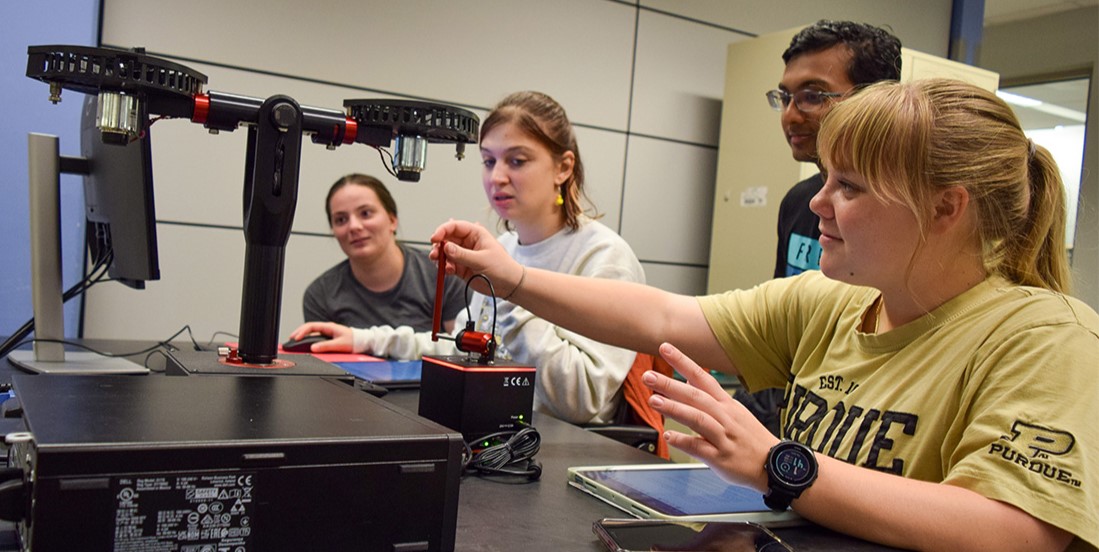Undergraduate Programs

The School of Aeronautics and Astronautics (AAE) is the largest and one of the best aerospace engineering programs in the nation. We graduate more students than anyone else, and are ranked No. 3 in the 2024 U.S. News & World Report rankings of undergraduate programs in aeronautics and astronautics.
Program Overview
Our program normally begins in your second year at Purdue, after completion of the common First Year Engineering Program. Find out how to enter First-Year Engineering and transition to Aeronautics and Astronautics on the AAE Admissions page.
Your sophomore year will set the foundation of basic engineering, including statics, dynamics, elementary structures, and thermodynamics, plus a broad introduction to the design of both aircraft and spacecraft.
In the junior year, students learn about aerodynamics, propulsion, structures, dynamics, and control systems. Some courses in the junior year are available in both aeronautical and astronautical versions, and students choose the version of primary interest.
In the senior year, students pursue, in consultation with their academic advisor, a specialization area. This is commonly chosen from the disciplines of:
- Aerodynamics
- Aerospace Systems Design
- Astrodynamics and Space Applications
- Autonomy and Control
- Propulsion
- Structures and Materials
All students must complete a team-based senior design project, which integrates the technical disciplines and leads to a preliminary design of an aerospace system. Students may elect either aircraft or spacecraft versions of the senior design project.
Students successfully completing the curriculum will be awarded the B.S. AAE degree. Students completing the 3+2 dual degree program with Morgan State will also receive a civil engineering or engineering physics degree from Morgan State.
Accreditation
The BS program in Aeronautical and Astronautical Engineering is accredited by the Engineering Accreditation Commission of ABET, https://www.abet.org, under the commission's General Criteria and Program Criteria for Aerospace and Similarly Named Engineering Programs. Our program meets the following ABET criteria:
"Aerospace engineering programs or similarly named engineering programs, which combine aeronautical engineering and astronautical engineering, must include all curricular topics in sufficient depth for engineering practice in one of the areas — aeronautical engineering or astronautical engineering as described above — and, in addition, similar depth in at least two topics from the other area."
Our program is listed on the ABET website.
Program Objectives
The objective of the undergraduate aeronautical and astronautical engineering program is to prepare students for careers in aerospace engineering and related disciplines.
We consider this objective to be achieved if:
- All graduates are meaningfully employed or self-employed in industry, government, or education, or are pursuing graduate studies within one year of graduation
- Most graduates are employed or self-employed in aerospace fields or pursue graduate work in aerospace engineering within one year of graduation
- Five years after graduation, most graduates are working in aerospace or other engineering fields
- Five years after graduation, most graduates have advanced their careers by, for example, promotion or pursuit of an advanced degree
- Most graduates report that their education at Purdue provided valuable preparation for their careers, whatever their field of endeavor.
Student Outcomes
Through the course of their studies, students shall gain:
- An ability to identity, formulate and solve complex engineering problems by applying principles of engineering, science, and mathematics
- An ability to apply engineering design to produce solutions that meet specified needs with consideration of public health, safety, and welfare, as well as global, cultural, social, environmental and economic factors.
- An ability to communicate effectively with a range of audiences
- An ability to recognize ethical and professional responsibilities in engineering situations and make informed judgments, which must consider the impact of engineering solutions in global, economic, environmental, and societal contexts
- An ability to function effectively on a team whose members together provide leadership, create a collaborative environment, establish goals, plan tasks, and meet objectives
- An ability to develop and conduct appropriate experimentation, analyze and interpret data, and use engineering judgment to draw conclusions
- An ability to acquire and apply new knowledge as needed, using appropriate learning strategies
